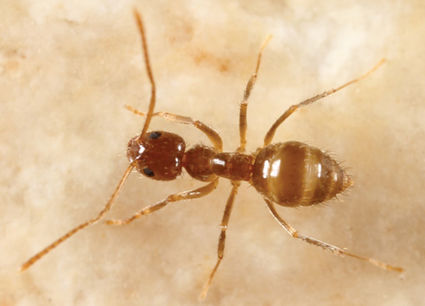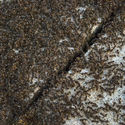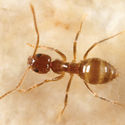These ants are crazy
Last updated 8/1/2012 at Noon
You will not find these ants marching in a straight line like good little soldiers. They also do not build traditional mounds with a central entrance or exit and they eradicate other ant populations including fire ants.
“It’s a Caribbean Crazy Ant,” said Martin McCord, owner of Pestco. “This particular ant was discovered by a guy out of Pasadena called Tom Rasberry.”
Rasberry discovered a species of ant that he had never seen before in the Houston area in 2002. He shipped samples to the Texas A&M Entomology Department.
What caught his attention was the erratic behavior of these ants. These ants form loose foraging trails as well as forage randomly (non-trailing) and crawl rapidly and erratically (hence the description “crazy” ant). They also do not colonize the way most species do in centralized mounds. They nest under logs or rocks; any place where moisture collects. They also have multiple queens according to McCord. There will literally be millions of them he said.
“[Rasberry] had them identified by Roger Gold out at A&M. [Gold] determined that they were a new invasive species of ant,” McCord said. According to A&M’s web site an common name for the ants has yet to be assigned and their species is yet to be determined. Since Rasberry was the first to discover the ants in the United States, they are currently being called Rasberry crazy ants
“Currently, little is known regarding the biology of this ant. The Center for Urban and Structural Entomology at Texas A&M University is investigating food source attraction, colony growth and immature development,” states the Web site. The worker ants can be spotted as uniformly-sized 1/8 inch long, reddish-brown ants in the landscape; foraging occurs indoors from outdoor nests.
Currently McCord has only found them in Vidor as far as Orange County is concerned. “I really haven’t run across the Rasberry crazy ant anywhere else in Orange Country.
They are in several Jefferson County locations. “They’re being transported primarily because of human behavior. In things that are being transported to different locations.”
Arriving in these new locations, McCord said they are very difficult to control. “They’re so large in population that they overcome fire ants and other insect populations.” They feed on other insects; dead or alive.
“There should be a real concern about the environment with this ant coming in and wiping out all other insect populations. They are very difficult to control because they have multiple queens. You kill one area and get one area under control and new queens will rise up. There is no distinctive nesting. Lots of times they are underneath things like maybe a piece of plywood or tarp that is laying on the ground. They seem to get underneath things and nest but there’s not a typical mound like with fire ants. They are just everywhere.”
“One customer in the in the Maple Crest addition of Vidor, he has an asphalt driveway and it looked like the driveway was moving because there were so many ants on it. It was unbelievable how many ants there could be on a property.”
McCord said they seem to be more active the dryer it is, because they are looking for moisture.
Maple Crest is an addition in Vidor that is isolated. It’s got Old Highway 90 on one side, FM 1132 on another, then Interstate 10 completes the triangular shaped containment area.
“It’s kind of an isolated addition, so these ants stayed in that addition, of course they are starting to move across 1132 and Highway 90, so they are starting to spread out from that point,” said McCord.
Many of the typical control tactics for other ants do not provide adequate control of the Rasberry crazy ant. Effective products involved with the treatments are not readily available to the consumer.
“There are some extended treatments available through the professionals,” said McCord. “We’ve got special permission from the State or extension agency to use some of the existing products that we have in a more extensive manor. We do have chemicals that control them and they are very low impact chemicals for the end user or customer and they are effective, but the thing about it, it’s only a matter of controlling these ants. You’re never going to eliminate them completely, with what we have today.
“First of all they’re Caribbean, so they like hotter temperatures. They come back in April and May, that’s when I notice them becoming more active in this environment that they’re in. The colder temperatures seems to stop their progress. In the late fall, November through the spring, you’re not going to see much of them,” said McCord.
“They don’t bite, they do wipe out other insect populations, but I’ve never known anybody to say they have been bitten by these ants, however, they are extremely damaging to electrical equipment and they tend to destroy air conditioner contacts or electronics.”
There is nothing the homeowner can do to stop them. McCord said they can use some products over the counter that stop them for maybe a couple of days, then they come right back. The dead ants killed by the chemicals will pile up and look like coffee grinds around the perimeter of your house or structure. As the dead pile up, they’ll keep coming and just walk over the top of the dead ants. They don’t stop.
“Most of the companies put their clients on a monthly routine to control the ants.” McCord said they will do an initial treatment that will stop and eliminate them in an area. Then to stay proactive, to keep them back, they will put them on a regular routine treatment schedule.
“They are not going to go away and it is only going to get worse with time,” said McCord. There are preventative measures you can do, either as a home owner or as a professional. If you know they are around in your area and want to keep them from getting started.
“Once they get established on a property it’s much more difficult to eliminate them. It’s much better to be proactive and go ahead and have a yard treatment,” said McCord.
Some chemicals will last three to six months, depending on the size of the population. Most of the time you will get at least a month out of the treatment according to McCord. Areas surrounded by “raw land” are more difficult to maintain. “They’re going to be coming out of the woods in droves,” said McCord.
There doesn’t seem to be an issue with bites or allergies at this point said McCord. “I’ve had them crawling all over me doing treatments, so I know first hand that they don’t bite. They didn’t bite me.”
For most applications to control pests other than crazy ants, Pestco uses chemicals that are user friendly and end user friendly; low impact chemicals and eco friendly chemicals that will control insects. “A lot of the chemicals we use, the EPA doesn’t even have to register them because they’re natural,” said McCord.
For more information on Rasberry Crazy Ants you can visit the Texas A&M Urban Entomology Web site at http://urbanentomology.tamu.edu/ants/rasberry.html#biology.
For treatment of crazy ants contact your local pest controller or Pestco at 409-791-3835.

















Reader Comments(0)